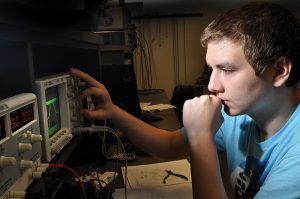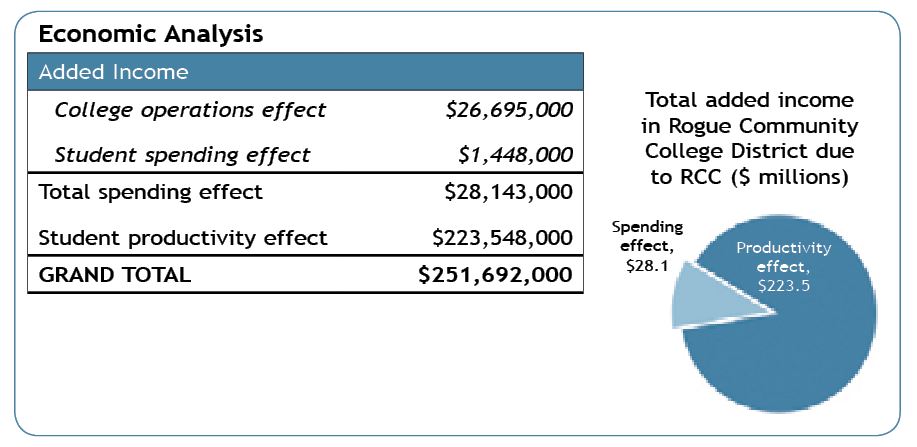 Rogue Community College has graduated more than 200,000 students and pumped millions of dollars into the economy since opening its doors in 1970.
Rogue Community College has graduated more than 200,000 students and pumped millions of dollars into the economy since opening its doors in 1970.
Financial aid alone, which RCC students receive to attend college, delivers about $35 million each year. About half that goes toward institutional expenses, according to Anna Manley, RCC director of Financial Aid, and the other half is refunded as excess aid for students to use toward cost-of-living expenses. That money is injected into the economy.
According to a recent study,* RCC and its former students contribute nearly $251.7 million annually to the regional economy. The study includes investment and economic growth analyses.
INVESTMENT ANALYSIS
The investment analysis calculates measurable returns of educational funding and compares those returns to costs from student, taxpayer and societal perspectives. It showed the following:
- For every dollar students invest in RCC, they receive a cumulative $6.30 in higher future income over the course of their working careers.
- Oregon benefits from improved health and reduced welfare, unemployment, and crime, saving the public some $1.7 million per year.
- Taxpayers see a rate of return of 9.1% on their investment in RCC.
The student perspective
In 2012-13, RCC had a total annual enrollment of about 16,640 full and part-time students. Most were Jackson and Josephine County residents. Many of those students hope that a higher education will translate into good jobs and brighter futures for themselves and their families.
According to the study, their hopes are not misplaced. Students enjoy the biggest benefit from RCC’s higher education offerings.
On average, graduates who hold an associate’s degree earn $8,500 more per year over the course of a lifetime than someone with only a high school diploma. Comparing favorably with other long-term investments like stocks and bonds RCC students enjoy a 17.6 percent rate of return on their investments of time and money. The payback period is 8.7 years.
The social perspective
In addition to individual benefit, taxpayers and society gain from students pursuing their educations at RCC.
Through higher incomes, RCC students expand the state’s economic base. The businesses that employ them become more productive through the students’ added skills. Combined with the associated ripple effects, these benefits contribute an estimated $36.3 million in taxable income to the Oregon economy each year.
As they achieve higher levels of education, RCC students are also less likely to smoke or abuse alcohol, draw welfare or unemployment benefits, or commit crimes. This avoids costs to the public and results in savings of approximately $1.7 million annually. These are benefits that are incidental to the operations of RCC and accrue for as long as students remain active in the workforce.
RCC provides an estimated social benefit/cost ratio of 33.8 with every dollar of state and local tax money invested in the college yielding a cumulative $33.80. These benefits accrue to all Oregon residents in added taxable income and avoided social costs.
The taxpayer perspective
From the taxpayer perspective, benefits enjoyed by state and local governments also are counted. These include increased tax collections (from higher wages) and reduced government expenditures (reduced crime, welfare, unemployment and health savings).
 RCC generates a 9.1 percent rate of return on and a benefit/cost ration of 2.9, which means every dollar of state or local taxes invested in RCC returns $2.90.
RCC generates a 9.1 percent rate of return on and a benefit/cost ration of 2.9, which means every dollar of state or local taxes invested in RCC returns $2.90.
ECONOMIC GROWTH ANALYSIS
RCC affects the local economy in three other ways: local purchases including faculty and staff wages, spending by out-of-district students attending RCC, and increased skills of the local workforce. The combined effect of these three factors amounts to a grand total of $251,692,000.
College operations contribute about $26.7 million through payroll and capital expenditures, which include purchasing materials and supplies as well as contracting for services.
Out-of-district or non-local students contribute another $1.4 million through spending money for room and board, transportation, entertainment and other miscellaneous personal expenses.
Lastly, student productivity affects economic growth when they leave RCC and enter the regional workforce.
Students added skills translate to higher income and a more robust regional economy of approximately $223.5 million annually.
The study concludes that RCC is a sound investment from multiple perspectives:
- Enriches the lives of students
- Increases their lifetime incomes
- Generates increased tax revenue
- Reduces the demand for taxpayer-supported social services
- Contributes to the vitality of state and local economies.
*Economic Modeling Specialists Intl.
2012 Executive Summary
